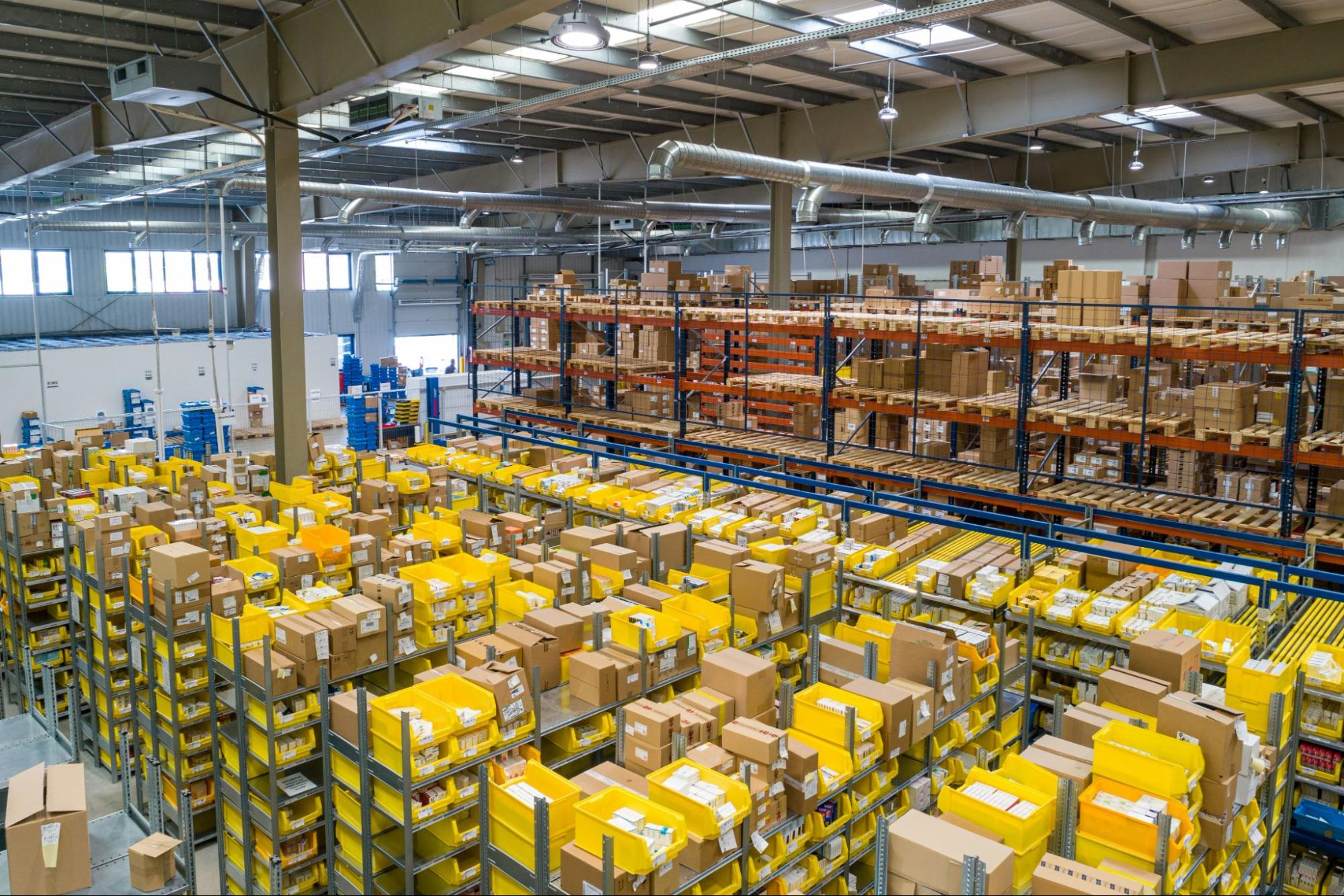Are Inventory Management and Warehouse Management the Same?
April 3, 2024 - 11 minutes readReviewing the important differences between these related concepts.

The term “warehouse” was first coined in Great Britain almost 700 years ago, but the concept of using large industrial buildings to store and organize goods originated at least 3,000 years earlier with the ancient grain silos of Egypt. In recent decades, computer technology and automation have redefined the warehouse as a hub of integrated supply chain, storage, and order fulfillment operations. Warehouse management systems (WMS) have been developed to control and monitor the flow of materials and infrastructure within complex modern warehouses.
Advanced inventory management software has also evolved to provide a source of real-time data, but the lines between inventory management and warehouse management are sometimes blurred. While there are a few similarities, the two practices also have some important differences.
“Goods sit in the warehouse until information moves them.” – C.J. Cherryh
Defining inventory and warehouse management
To adequately describe the differences between warehouse management and inventory management, it helps to start with some basic definitions:
- Inventory management: The tracking of inventory from manufacturers to inventory locations and the management of related processes, including the ordering, buying, and movement of products and materials.
- Warehouse management: A set of processes used to organize and control work performed in a warehouse or distribution center so that storage, picking, packing, and space utilization are optimized.
- Order management: A system established to control and monitor the processing, fulfillment, shipment, and traceability of customer orders and returns.
- Customer relationship management (CRM): A business strategy that utilizes sales, marketing, customer service, and digital marketing data sets to improve customer satisfaction and loyalty.
7 Important differences between inventory and warehouse management
At a high level, inventory management and warehouse management are defined by the terms themselves. Products and materials line the shelves of most warehouses, but a warehouse is also a physical space with loading docks, material handling equipment, and layouts that must be established and optimized.
On the other hand, inventory can extend far beyond the warehouse, encompassing the external supply chain, transportation networks, and customer order management and return processes. The fundamental differences between inventory and warehouse management include:
1. Scope of work
Inventory management systems focus on the collection and analysis of real-time inventory data to ensure stock availability, support forecasting, and determine preferred stock levels and reorder points. Although inventory management is primarily focused on material tracking and data analysis, the integration of E-commerce platforms and external storage locations to facilitate omni-channel commerce has expanded the inventory management scope.
The field of warehouse management is broader in many ways, since the focus expands to include anything that impacts warehouse operations, including the building, workers, and material handling equipment. Inclusion of the human element means warehouse processes like picking orders and packing shipments are analyzed holistically, rather than reviewing part movement and inventory transactions alone.

2. Floor space utilization
Inventory management systems often track location information along with the part number, quantity, and descriptive data that facilitate decision-making processes, but they do not analyze physical storage constraints and material locations in detail. Warehouse management systems are designed to review and optimize floor and rack space utilization to ensure the layout is efficient and safe. This analysis can include:
- Floor layout optimization based on demand
- Space utilization percentage calculations
- Cross-docking optimization
- Item placement for picking efficiency
Space optimization practices also encompass advanced measurement and modeling techniques to align package and part sizes with rack locations to minimize wasted space. Careful analysis of the warehouse layout also prevents dead zones, bottlenecks, and dangerous working conditions.
3. Shipping and receiving
Reviewing the entrance and exit of materials from a warehouse or storeroom provides a window into overall business success and efficiency. Inventory management and warehouse management systems view these important operations from slightly different perspectives. Inventory management software is an ideal tool for the real-time tracking of:
- Quantities delivered
- Part movement within the warehouse
- Items pulled from stock for order fulfillment
- Orders leaving the facility
Warehouse management systems are used to review the efficiency of shipping and receiving processes. This includes metrics like truck waiting queues, loading times, order processing times, and variances between individual workers that help to pinpoint underlying constraints and bottlenecks.
4. Hard order allocation
Order allocation is an additional area where the role of inventory management and warehouse management differ significantly. Hard allocation refers to the reservation of individual items or full pallets in the warehouse for specific orders or customers. Hard allocated or reserved inventory often requires labeling or relocation to a designated area to prevent mixing with unallocated inventory.
While the data related to order allocation and availability is accessible using inventory management software, warehouse management systems ensure the physical disposition of inventory is completed successfully.
5. Transportation management
74% of supply chain organizations utilize four or more different forms of transportation. Third party transportation companies, expeditors, and conventional carriers introduce risks for E-commerce retailers and other businesses that rely on timely delivery of parts to the warehouse and orders to the customer.
Inventory management focuses on the availability of stock to meet demand, which makes the timing and coordination of transportation services important considerations. Warehouse management practices ensure products are packaged, labeled, and routed correctly so that problems like missed deliveries, part mix-ups, and damage-in-transit can be prevented.
“We want transportation as reliable as running water.” – Travis Kalanick
6. Customer interaction
The goal of any business system is to enhance brand value through satisfied customers. This applies to inventory management and warehouse management systems as well, although the customer interface is more direct with inventory management. Real-time availability and price information is communicated from inventory management systems directly to customers through platforms like E-commerce stores and point of sale (POS) systems.
Warehouse management systems ensure the physical handling, storage, and movement of inventory within the warehouse is optimized to support customer orders, but the indirect influence of these operations is typically much less visible to customers.
7. Software tools
The differences between inventory management and warehouse management are evident in the software packages and apps that carry out these services. Mobile warehouse management apps are ideal for tracking and managing tasks like picking, packing, receiving, and cycle counts that reflect the flow of materials within the warehouse.
Inventory management software takes a broader view of inventory status, which includes demand forecasting, order processing, and supply chain management. The best inventory management platforms also support omni-channel commerce by combining data from in-store, online, and 3rd party marketplace sources through a common interface.
Integrating inventory and warehouse management
Inventory management and warehouse management systems can work hand-in-hand, painting a more comprehensive picture of the business and order fulfillment environments to prevent unforeseen delays and errors.
- Inventory management data supports warehouse management by providing an in-depth source of information on stock levels, order allocation, and demand.
- Warehouse management apps support the inventory management process by feeding real-time receipt, order picking, and cycle count data back to the inventory management database.
A well-designed and integrated system maximizes the potential of both systems while ensuring information conflicts and overlaps are minimized. Collaboration between the two platforms also improves overall supply chain performance and operational efficiency.
Inventory and warehouse management: Final thoughts
Although they evolved independently, inventory management and warehouse management systems both help optimize order accuracy and supply chain efficiency while enhancing the customer experience. Each system has unique attributes that add value to the organization and provide a useful source of information for other systems and databases. By leveraging the synergies between these systems, businesses can develop more agile and responsive operations.
The cloud-based Agiliron product suite supports a comprehensive, integrated approach to inventory management with scalable, mobile-friendly solutions that integrate seamlessly with all leading E-commerce platforms. Warehouse management and CRM apps reinforce data collection and decision-making processes, while our mobile point of sale (POS) software allows you to sell in more places but manage from one.
Warehouse management and inventory management software working in tandem can optimize efficiency and safeguard order fulfillment throughout the supply chain. Integrating these valuable systems becomes easier with some expert guidance and support. Contact us today to discover how warehouse management software is taking real-time inventory visibility to the next level.
Tags: inventory management